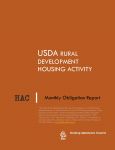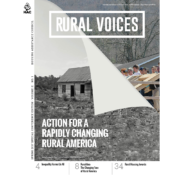HAC News: May 26, 2017
HAC News Formats. pdf
Vol. 46, No. 11
Administration’s FY18 USDA budget would eliminate many rural housing programs • USDA proposes reorganization with substantial change to Rural Development • Budget proposes to eliminate significant HUD programs and others • USDA offers Community Facilities Technical Assistance and Training grants • HUD requests input on reducing regulations and costs • Public invited to suggest Executive Branch improvements • Clarifications issued for allowable expenses in RD multifamily properties • Webinar planned on HUD’s Manufactured Home Dispute Resolution Program • REGISTER TO KEEP YOUR HAC NEWS SUBSCRIPTION ACTIVE
HAC News Formats. pdf
May 26, 2017
Vol. 46, No. 11
Administration’s FY18 USDA budget would eliminate many rural housing programs. Direct rural housing lending would be eliminated, along with several grant programs, under the first full budget proposal from the Trump Administration, released on May 23. The budget would maintain assistance for current renters through the Section 521 Rental Assistance and Section 542 rural voucher programs, but all rental housing preservation efforts would be defunded, as would the self-help homeownership program. RD staffing would be cut by 925 staff years; a table in one of the budget documents shows how many positions would be eliminated in each state.
A new Rural Economic Infrastructure Grant program would combine Section 504 grants with Community Facilities grants, telemedicine distance learning grants, and broadband grants. The four programs received a total of $133.6 million in FY17. The combined pool would get $162 million under the FY18 budget, $80 million of which is earmarked for Appalachia. (The Appalachian Regional Commission, however, would be eliminated, along with the Delta Regional Authority, the Denali Commission, and the Northern Border Regional Commission.)
HAC has posted online a recording and materials from its webinar May 25 reviewing the budget, the upcoming funding process for FY18, and USDA’s reorganization proposal (see article below); more details and a statement on the RD budget proposal; and more details and a statement on the reorganization proposal.
| USDA Rural Dev. Prog. (dollars in millions) |
|||
|
502 Single Fam. Direct |
$900 |
$1,000 |
0 |
|
502 Single Family Guar. |
24,000 |
24,000 |
24,000 |
|
504 VLI Repair Loans |
26.3 |
26.3 |
0 |
|
504 VLI Repair Grants |
28.7 |
28.7 |
a |
|
515 Rental Hsg. Direct Lns. |
28.4 |
35 |
0 |
|
514 Farm Labor Hsg. Lns. |
23.9 |
23.9 |
(-11)b |
|
516 Farm Labor Hsg. Grts. |
8.3 |
8.3 |
0 |
|
521 Rental Assistance |
1,390 |
1,405c |
1,345 |
|
523 Self-Help TA |
27.5 |
30 |
(-4)b |
|
533 Hsg. Prsrv. Grants |
3.5 |
5 |
0 |
|
538 Rental Hsg. Guar. |
150 |
230 |
250 |
|
Rental Prsrv. Demo. (MPR) |
22 |
22 |
(-4)b |
|
542 Rural Hsg. Vouchers |
15 |
19.4 |
16 |
|
Rural Cmnty. Dev’t Init. |
4 |
4 |
0 |
a. Would become part of Rural Economic Infrastructure Grant program.
b. Budget proposes to rescind unobligated funds from three programs: $11 million from Sec. 523 self-help, $4 million from Sec. 514/516 farm labor housing, and $4 million from MPR.
c. Includes $40 million in advance funding for FY18, so total available in FY17 is $1.365 billion and total available in FY18 would be $1.385 billion.
USDA proposes reorganization with substantial change to Rural Development. In a report to Congress released on May 11, USDA has proposed to “realign” its RD mission area so the Rural Housing Service, Rural Business-Cooperative Service, and Rural Utilities Service administrators report directly to the Secretary of Agriculture. The document focuses on USDA’s trade functions, and also emphasizes changes related to farm production. It is not clear what the elimination of the Under Secretary for Rural Development would mean, but HAC and others have expressed concerns.
Comments on the proposal can be submitted by June 14. HAC is preparing comments and hopes to have them available on its website before the deadline.
USDA Secretary Sonny Perdue appeared before the House Agriculture Committee on May 17 to talk about the rural economy, and faced a number of questions about the reorganization’s impact on RD; a summary is posted on HAC’s website. When Perdue testified about the FY18 budget before the House Agriculture Appropriations Subcommittee on May 24, both Republican and Democrat members raised questions about not only the budget’s proposed cuts, but also the reorganization. In both hearings, Perdue said repeatedly that, despite the elimination of the RD Under Secretary, the changes would elevate RD.
Budget proposes to eliminate significant HUD programs and others. The Administration’s budget would do away with the CDBG, Indian CDBG, HOME, and SHOP programs. Outside HUD, it would defund the National Housing Trust Fund, the Indian CDBG program, most CDFI Fund programs, the U.S. Interagency Council on Homelessness, and the Neighborhood Reinvestment Corporation.
|
HUD Program |
|||
|
Cmty. Devel. Fund |
$3,060 |
$3,060 |
$0 |
|
HOME |
950 |
950 |
0 |
|
Self-Help Homeownshp. (SHOP) |
10 |
10 |
0 |
|
Tenant-Based Rental Assistance |
19,628 |
20,292 |
19,318 |
|
Project-Based Rental Asstnce. |
10,622 |
10,816 |
10,351 |
|
Public Hsg. Capital Fund |
1,900 |
1,942 |
628 |
|
Public Hsg. Operating Fund |
4,500 |
4,400 |
3,900 |
|
Choice Neighbrhd. Initiative |
125 |
137.5 |
0 |
|
Native Amer. Hsg. Block Grant |
650 |
654 |
600 |
|
Homeless Assistance Grants |
2,250 |
2,383 |
2,250 |
|
Hsg. Opps. for Persons w/ AIDS |
335 |
356 |
330 |
|
202 Hsg. for Elderly |
432.7 |
502.4 |
510 |
|
811 Hsg. for Disabled |
150.6 |
146.2 |
121 |
|
Fair Housing |
65.3 |
65.3 |
65 |
|
Healthy Homes & Lead Haz. Cntl. |
110 |
145 |
130 |
|
Housing Counseling |
47 |
55 |
47 |
USDA offers Community Facilities Technical Assistance and Training grants. A new program will make grants to public bodies and private nonprofits to provide technical assistance or training with respect to community facilities programs. Applications are due July 24. Contact an RD State Office or Shirley Stevenson, RD, 202-205-9685.
HUD requests input on reducing regulations and costs. As instructed by recent Executive Orders, HUD is reviewing its existing regulations to assess their compliance costs and reduce regulatory burden. HUD invites public comments to assist in identifying regulations that may be outdated, ineffective, or excessively burdensome. Comments are due June 14, 2017. For more information, contact Ariel Pereira, HUD, 202-402-5138.
Public invited to suggest Executive Branch improvements. Suggestions for improvements to the organization and functioning of federal executive agencies are due by June 12.
Clarifications issued for allowable expenses in RD multifamily properties. An Unnumbered Letter dated April 28, 2017 clarifies what expenses can be charged against project income in Section 515 and Section 514 multifamily properties. For more information, contact an RD State Office.
Webinar planned on HUD’s Manufactured Home Dispute Resolution Program. HUD’s Office of Manufactured Housing Programs will explain the program and answer questions on June 27 at 2:00 Eastern. For more information and to register, visit https://www.huddrp.net/events/. (See HAC News, 3/2/17.)
|
REGISTER TO KEEP YOUR HAC NEWS SUBSCRIPTION ACTIVE. Thank you for reading the HAC News, the premier source of information on rural housing for over 45 years. HAC is developing a new and improved distribution system for the newsletter. As a part of this process, we need you to update your registration to the HAC News. We estimate the entire process will take less than a minute. You must complete the registration process by May 30, or you will no longer receive direct mailing of the HAC News. Questions? Contact portal@ruralhome.org. |



 Ruralities: The Changing Face of Rural America
Ruralities: The Changing Face of Rural America